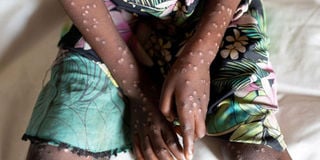
A person presenting with signs and symptoms of Mpox disease. PHOTO | FILE
The Democratic Republic of the Congo (DRC) is no stranger to mpox. The first human case of the disease was recorded in the war-torn country in 1970 after its initial discovery in monkeys held in Danish laboratories for research two decades earlier (1958).
According to the World Health Organisation (WHO), the DRC is among a dozen countries in Africa that are endemic for the mpox virus. The other countries include Benin, Cameroon, the Central African Republic, Gabon, Ghana (identified in animals only), Côte d’Ivoire, Liberia, Nigeria, the Republic of the Congo, and Sierra Leone.
Mpox regularly occurs within the confines of the aforesaid countries. In light of the recent developments in the DRC, where a dangerous variant of mpox is on a seemingly inexorable march, the WHO has made it patently clear that urgent action is needed.
How close is this new dangerous mpox strain to Uganda’s borders?
Early this week, the chief epidemiologist at Uganda’s Health ministry told this newspaper that the new mpox strain in the DRC is being looked at “with a view of preparations on our side.” Lt Col Dr Henry Kyobe also disclosed that Uganda has “a response plan which we are revising and, of course, heightening our case finding and then public awareness, specifically for the at-risk population.” Which is just as well.
The Uganda-DRC border length straddles 950kms, and it is punctuated with many porous crossing points. But this is only half of the story.
It was last September when empirical evidence pointed to mpox infections spreading via humans through sexual contact.
This was in Bukavu, a mining city that hugs the south-western edge of Lake Kivu.
The sexual contacts that have led to the transmission of the new strain were between bar workers and mining workers in Bukavu.
The porous borders at Ruzizi and Gisenyi have threatened to suck in sex workers from Rwanda and Burundi into what already looks like a tinderbox.
Why is mpox nowadays spreading so easily in humans?
This is anything but a first. It is estimated that mpox has been circulating in humans since at least 2016.
The 2022 global outbreak had, per the WHO, cases “mainly but not exclusively … identified among men who have sex with men (MSM).” That outbreak was driven by a virus that was reported not to pack a punch anywhere near what the new variant in the DRC currently mustered.
The 2022 strain that was registered in hundreds of non-endemic countries was summarily brought under control with the aid of vaccines and treatments. The current outbreak in the DRC presents markedly different hurdles, including steep challenges dispensing the vaccines across the country’s remote plains.
Health officials in the DRC are worried that the disease could potentially spread to the sprawling border shared with Uganda.
This is principally because, since the rainy season is now being viewed through the rearview mirror, there will be more than an uptick in cross-border movements sooner rather than later.
This increases the chances of what has been described as “the most dangerous variant yet” spreading.
Can vaccines put the brakes on the seemingly inexorable march of mpox?
The vaccines used to deal with the virus outbreak in 2022 were intended for smallpox.
The cross effectiveness, which conservative figures put at 80 percent, should not come as a surprise since the MPXV virus is a member of the same family of viruses as smallpox. Scientists attribute the effectiveness of the vaccines to the fact that mpox is much less severe than smallpox. The vaccines were only administered to at-risk people (i.e. those who have been in close contact with an infected person) since they remain in scant supply.
Stockpiles of smallpox jabs were previously easy candidates for being disposed of not least because the world was declared smallpox-free in May of 1980. Also worth noting is that the WHO frowns upon vaccinating populations in their entirety.
How does it spread?
While the jump from non-humans to humans was first discovered in 1970, the first reported case of human-to-animal transmission was in 2022. A Paris resident afflicted by mpox transmitted the infection to their dog, an Italian greyhound.
The MPXV virus spreads through close contact with infected persons or animals. This can be through sexual encounters, skin-to-skin contact, as well as not managing to socially distance.
The pathogen enters the body through broken skin, the respiratory tract or via the eyes, nose or mouth. Objects contaminated by the virus are also spreaders, the WHO reveals.
What are the mpox symptoms?
According to the WHO, someone afflicted by mpox presents with headache, rashes, muscle aches, fever and chills, exhaustion, as well as swollen lymph nodes.
Fever, headaches, swellings, back pain and aching muscles symptoms. A rash that spreads from the face to other parts of the body typically follows the fever. Itchy, if painful, the rash’s progression culminates into lesions that can cause scarring. The first appearance of the aforementioned symptoms (i.e. usual onset) could be anywhere between five and 21 days and could last for up to four weeks.
The viral disease particularly knocks children sideways as a fatality rate north of nine percent indicates. It can also be quite brutal on pregnant women and people with immunosuppression (i.e. those with increased susceptibility to disease).





